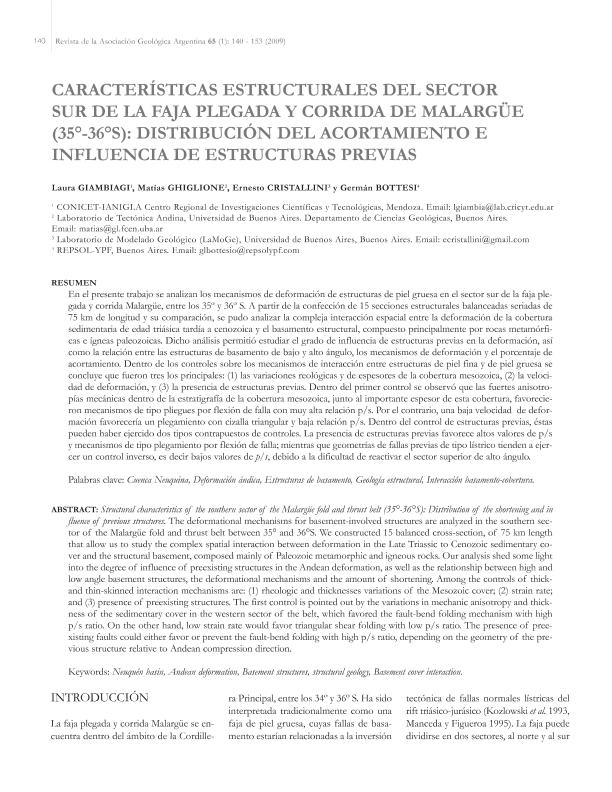Artículo
En el presente trabajo se analizan los mecanismos de deformación de estructuras de piel gruesa en el sector sur de la faja plegada y corrida Malargüe, entre los 35º y 36º S. A partir de la confección de 15 secciones estructurales balanceadas seriadas de 75 km de longitud y su comparación, se pudo analizar la compleja interacción espacial entre la deformación de la cobertura sedimentaria de edad triásica tardía a cenozoica y el basamento estructural, compuesto principalmente por rocas metamórficas e ígneas paleozoicas. Dicho análisis permitió estudiar el grado de influencia de estructuras previas en la deformación, así como la relación entre las estructuras de basamento de bajo y alto ángulo, los mecanismos de deformación y el porcentaje de acortamiento. Dentro de los controles sobre los mecanismos de interacción entre estructuras de piel fina y de piel gruesa se concluye que fueron tres los principales: (1) las variaciones reológicas y de espesores de la cobertura mesozoica, (2) la velocidad de deformación, y (3) la presencia de estructuras previas. Dentro del primer control se observó que las fuertes anisotropías mecánicas dentro de la estratigrafía de la cobertura mesozoica, junto al importante espesor de esta cobertura, favorecieron mecanismos de tipo pliegues por flexión de falla con muy alta relación p/s. Por el contrario, una baja velocidad de deformación favorecería un plegamiento con cizalla triangular y baja relación p/s. Dentro del control de estructuras previas, éstas pueden haber ejercido dos tipos contrapuestos de controles. La presencia de estructuras previas favorece altos valores de p/s y mecanismos de tipo plegamiento por flexión de falla; mientras que geometrías de fallas previas de tipo lístrico tienden a ejercer un control inverso, es decir bajos valores de p/s, debido a la dificultad de reactivar el sector superior de alto ángulo. The deformational mechanisms for basement-involved structures are analyzed in the southern sector of the Malargüe fold and thrust belt between 35° and 36°S. We constructed 15 balanced cross-section, of 75 km length that allow us to study the complex spatial interaction between deformation in the Late Triassic to Cenozoic sedimentary cover and the structural basement, composed mainly of Paleozoic metamorphic and igneous rocks. Our analysis shed some light into the degree of influence of preexisting structures in the Andean deformation, as well as the relationship between high and low angle basement structures, the deformational mechanisms and the amount of shortening. Among the controls of thickand thin-skinned interaction mechanisms are: (1) rheologic and thicknesses variations of the Mesozoic cover; (2) strain rate; and (3) presence of preexisting structures. The first control is pointed out by the variations in mechanic anisotropy and thickness of the sedimentary cover in the western sector of the belt, which favored the fault-bend folding mechanism with high p/s ratio. On the other hand, low strain rate would favor triangular shear folding with low p/s ratio. The presence of preexisting faults could either favor or prevent the fault-bend folding with high p/s ratio, depending on the geometry of the previous structure relative to Andean compression direction.
Características Estructurales del Sector Sur de la Faja Plegada y Corrida de Malargüe (35°-36°S): Distribución del Acortamiento e Influencia de Estructuras Previas
Título:
Structural characteristics of the southern sector of the Malargüe fold and thrust belt (35°-36°S): Distribution of the shortening and in fluence of previous structures
Fecha de publicación:
12/2009
Editorial:
Asociación Geológica Argentina
Revista:
Revista de la Asociación Geológica Argentina
ISSN:
0004-4822
Idioma:
Español
Tipo de recurso:
Artículo publicado
Clasificación temática:
Resumen
Archivos asociados
Licencia
Identificadores
Colecciones
Articulos(IANIGLA)
Articulos de INST. ARG. DE NIVOLOGIA, GLACIOLOGIA Y CS. AMBIENT
Articulos de INST. ARG. DE NIVOLOGIA, GLACIOLOGIA Y CS. AMBIENT
Articulos(IDEAN)
Articulos de INSTITUTO DE ESTUDIOS ANDINOS "DON PABLO GROEBER"
Articulos de INSTITUTO DE ESTUDIOS ANDINOS "DON PABLO GROEBER"
Citación
Giambiagi, Laura Beatriz; Ghiglione, Matias; Cristallini, Ernesto Osvaldo; Bottesi, Federico; Características Estructurales del Sector Sur de la Faja Plegada y Corrida de Malargüe (35°-36°S): Distribución del Acortamiento e Influencia de Estructuras Previas; Asociación Geológica Argentina; Revista de la Asociación Geológica Argentina; 65; 1; 12-2009; 140-153
Compartir




